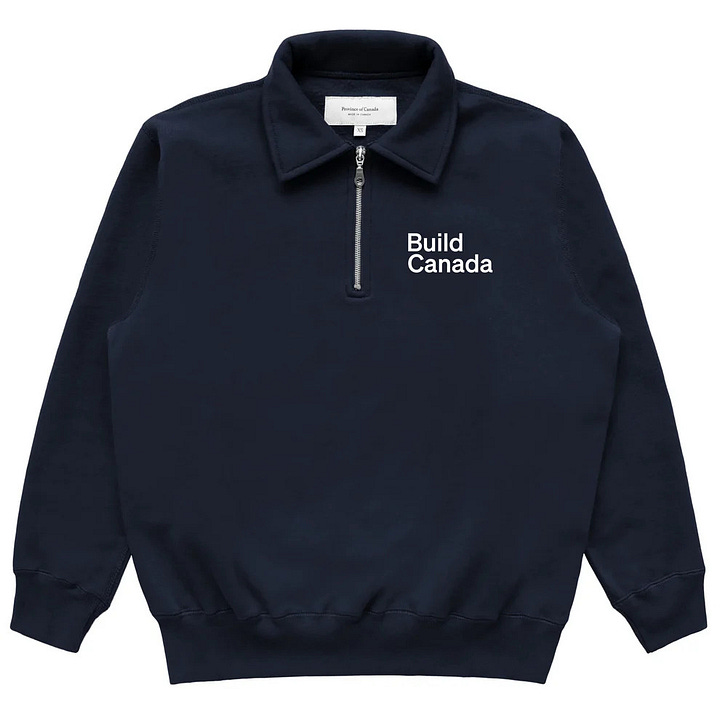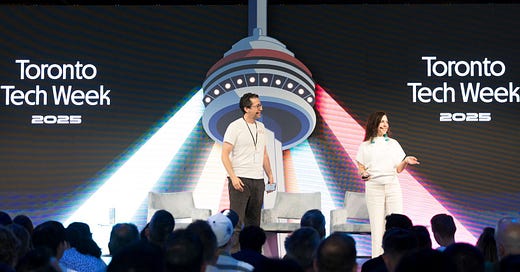Let's giv'er
Build Canada scales up. A new target for NATO. Trump ends trade talks. And merch!
As far as we’re concerned the biggest news this week is: Build Canada is scaling up! On stage at Toronto Tech Week’s Homecoming event last Tuesday, two of Build Canada’s founders, Daniel Debow and Lucy Hargreaves (pictured above), announced that Build Canada would be scaling up in its scope, its activities, and its ambition. Hargreaves also announced that she would be leaving her position at Patch, the San Francisco-based climate impact software startup. She is taking on the role of CEO at Build Canada, while Debow will be the Board Chair.
We have big plans and big hopes for Build Canada, and here are three things we are trying to build right now:
High-agency communities. Join a Build Canada project—groups of people shipping code, campus clubs, hosting events.
Permissionless policy ideas. At Build Canada, volunteers use AI tools to turn dinner-table frustrations into policy briefs and publish them transparently on our platform.
A new national narrative. Celebrate Canadian successes loudly and immediately—especially the messy early wins. The neighbourhood kids’ lemonade stand; a pro-growth, alt-media company run by high school students that gets its first 10K subscribers; a local company that reaches its first $1M in revenue; or someone who moves back to Canada to build here. We will broadcast them like playoff victories, and hope the success is contagious.
There will be more on all of this very soon. But we are very excited for what is to come, and we hope you will join us in trying to make Canada the most prosperous country in the world. In the meantime, you can sign-up to get involved and learn about volunteering opportunities as they arise.
Or, you can show your support through:
Merch Store now open for pre-orders




For a limited time only, we’re opening a merch store. We worked with our friends at Province of Canada and Outway Socks to create limited edition Build Canada merch, including tees, zips, hats and socks.
Open for 1 week only. Pre-orders close Fri July 4 at 6pm ET.
Even more money for defence
The other big news of the week came out of the NATO summit in The Hague, where the leaders of member countries agreed to raise their levels of defence-related spending to 5% of GDP by 2035. This would give Canada a defence budget in the ballpark of $110-150 billion, more or less double what we currently spend.
There are a number of hedges built into the agreement though, the most telling one being the agreement to revisit the 5% pledge in 2029. A second is that there are actually two spending targets here: the first is to spend 3.5% of GDP on the military, the second is an additional 1.5% on “defence-related” infrastructure spending. Additionally, the NATO communique said that contributions to Ukraine’s defence against Russia will count toward the military spending target.
Still, by any measure, this is a lot of money. The last time Canada spent anywhere near 5% of GDP on defence was during the Cold War buildup of the 1950s coming out of the Korean War.
A few things to note about all of this. First, it’s going be hard to find the money. Canada has just (almost, barely) managed to reach the old NATO target of 2%, and getting to the new level will require annual defence budget increases of 7-10%. The only way Ottawa can find the money is by cutting spending elsewhere, raising taxes, or borrowing.
Former Clerk of the Privy Council Michael Wernick has suggested that Ottawa should establish a “Defence and Security Tax” parallel to the GST that would go in to a dedicated fund that only specific departments and agencies could draw on. This strikes us as a bad idea for a number of reasons though, not least of which is that defence and security is the main job of the federal government. If anything needs to be funded out of dedicated taxes, it should be the various boutique programs that Ottawa funds in areas of provincial responsibility, such as dental care.
But Wernick is right about the basic math — there just isn’t that much that can be cut in the federal budget (defence is already the single largest discretionary item). And since Prime Minister Carney is already budgeting for a cut in income taxes, and since so much of Ottawa’s spending consists of transfers, it looks like debt is the only way this happens.
Once the money is appropriated, another problem will be actually spending it. A lot of Canada’s defence problems stem not from a lack of investment, but from more structural or bureaucratic obstacles. Procurement is famously a complete disaster, while the CAF’s recruitment and retention problems are ongoing and getting worse.
Finally, Carney is going to have to do some work convincing Canadians that this is all necessary. While it is true that support for rearming the CAF has been high since Donald Trump took office (a pre-election poll commissioned by Build Canada showed three quarters of Canadians were in favour of more military spending), it is going to be hard to justify Cold War levels of rearmament without a clear and present danger to the country.
That is why some analysts have suggested that what is important is that Canadians can see all of this spending as more than just a deadweight loss to the economy and to their wellbeing. If there are clear spinoff benefits in the form of increased productivity, home-grown IP, a strong industrial base and domestic industry, higher employment, research spinoffs, and other dual-purpose gains, then the 5% target will be more politically sustainable than if it is framed as simple deterrence.
For more on this, check out our Build Canada memo on recapitalizing the armed forces, sponsored by Shaun Francis. More recently, a pair of RBC economists have written a good analysis of just what greater defence spending could mean for the Canadian economy in general.
Dismissals are on the table?
While it doesn’t get major headlines outside of Ottawa, it is clear that Prime Minister Carney is starting to rattle cages at the highest level of the public service. The Globe’s Robert Fife had a story this week – sourced, in typical Fife style, from a number of anonymous insiders – which claimed that Carney has made it it clear to senior officials that if they cannot move with the pace and urgency he is demanding, they will be moved, demoted, or even dismissed.
At the heart of it is a sense of frustration that the public service is run by people who “seem more focused on process than outcomes” and who suffer from a profound sense of “analysis paralysis.” And this all part of a more general attempt by Carney to bring a more professional, businesslike, and efficient approach to governing: “He’s made it clear, for example, that he expects cabinet ministers and deputy ministers to show up on time for meetings, to be well prepared and to have answers to his probing questions.”
While a lot of attention has been directed at the “old white guys” that Carney has brought in to execute his agenda – most notably Michael Sabia as Clerk of the Privy Council, and PMO chief of staff Marc-André Blanchard – there have already been a number of changes in the senior ranks of the public service, with an emphasis on less box-ticking and more on delivering results.
These moves have drawn praise from a number of former senior bureaucrats, some of whom say “it’s about time”. This includes David McLaughlin, former chief of staff to Brian Mulroney, who told The Hill Times that he thinks Carney does not have the right people in the right jobs to achieve his agenda — the whole apparatus “needs an overhaul.” For some ideas of what could be done to achieve a more productive federal government, Build Canada CEO Lucy Hargreaves wrote a memo on the subject in early April.
Trump ends trade talks
Well, the trade peace was fun while it lasted. Coming out of last week’s G7 meeting in Kananaskis, Canada and the U.S. appeared to be on a path to resolving their various trade disputes, with Canada having extracted from the Americans a commitment to reach some sort of trade deal within 30 days. But any momentum there came screeching to a halt on Friday, when Donald Trump posted a note on his Truth Social platform announcing a sudden end to negotiations. The point of contention, according to Trump, is Canada’s decision to proceed with a digital services tax that would apply to major American tech firms such as Google and Amazon. In the post Trump also complained about Canada’s supply management system for dairy products, and said he would be imposing fresh tariffs on Canada within the next seven days.
A number of Canadian business leaders had been urging the federal government to pause the tax, warning of precisely this sort of retaliation by Trump. Ottawa might have been feeling secure in its position thanks to an agreement that came out of the G7 that saw the removal of a “revenge tax” provision in Trump’s tax bill, but which did not cover the digital services tax.
But ultimately, it seems like this might just be part of what is by now a familiar Trump negotiating style of maximal bombast and aggression. In the meantime, Ottawa insists that negotiations are continuing, and there are strong indications that the feds are willing to drop the tax. They want to do it, though, as part of more comprehensive negotiations with Europe, which has a similar tax in place.
One Canadian Economy is official
The Senate has passed Bill C-5, the One Canadian Economy Act. This is Carney’s signature legislation that was actually two bills packaged together — one bill to lower federal barriers to internal trade, another to provide a means to fast track approvals for critical major projects. There had been some concern that the Senate would seek to amend, stall, or otherwise put off passing the bill, given opposition from environmentalists, some indigenous leaders, and others concerned with democratic accountability, but in the end it was passed without much fuss.
Indeed, the only real concern came on Wednesday, when Senator Patrick Brazeau fainted on the floor of the Senate while speaking about the bill. Thankfully it seems to have just been a dizzy spell, and he seems to be recovering well. (Reports are that Brazeau said “Oh shit” before collapsing, though it does not seem to have made it into the official record.)
What else we’re reading
Take a Gander at this! A Canadian social media platform gets ready to launch
Speaking of launches, we are excited for Canada’s first sovereign space launch
AI Minister Evan Solomon has big plans to scale the industry
Last weekend’s Globe and Mail had a great long read on how Newfoundland and Labrador and Quebec kissed and made up (with a cameo from Michael Sabia)




Post has been updated because we wrote "million" instead of "billion" in the defence spending section. Sorry!
"The only way Ottawa can find the money is by cutting spending elsewhere, raising taxes, or borrowing." This statement is fundamentally untrue. Federal budgets are a plan for a given fiscal year proposed by the Finance Minister and voted on by parliament. The money in that budget does not come from taxes previously collected -- it comes from the currency issuing authority i.e., the central bank. There are only two basic reasons a currency issuing government (such as Canada's) implements taxes: 1/ to create a demand for its currency (i.e., by requiring taxes be paid in that currency) and 2/ to control inflation, including any inflation that might result from the federal government's own spending. The federal government *can* borrow, but it does not *have to* in order to fund what it wants to spend on. Even if Canada were to borrow, it's own data on borrowings show 97.9 percent of borrowings are its own Treasury Bills or bonds, all of which are payable in Canadian currency: https://www.canada.ca/en/department-finance/services/publications/debt-management-report/2022-2023.html#a16 Taxpayers do not fund the governments who issue their own currency: https://www.mmt.works/mmt-taxes-do-not-fund-government-spending/ Any government that issues its own currency and has monetary sovereignty (as Canada does) can instruct its central bank to credit whatever accounts it wants credited. As a central banker, Carney is well aware of all this.